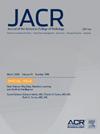ACR Appropriateness Criteria® Penetrating Torso Trauma
IF 4
3区 医学
Q1 RADIOLOGY, NUCLEAR MEDICINE & MEDICAL IMAGING
引用次数: 0
Abstract
This document assesses the appropriateness of various imaging studies for acute penetrating trauma to the torso. Penetrating trauma most commonly occurs from gunshots and stabbings, although any object can impale the patient. Anatomic location, type of penetrating trauma, and hemodynamic status are among the many important factors when deciding upon if, what, and when imaging is needed to further evaluate the patient. Imaging plays a critical role in the management of these patients. CT, in particular, aids in identifying and predicting internal injuries based upon trajectory of the object. Clinical variants are distinguished by ballistic versus nonballistic injuries, hemodynamic status, and compartment of the body injured. Ballistic trauma trajectory is less predictable, and imaging recommendations are adjusted for this unpredictability. Excluded from this document are penetrating traumatic injuries to pediatric patients and specific recommendations when the genitourinary system is clinically suspected to be injured, the latter of which is more specifically discussed in other Appropriateness Criteria documents.
The American College of Radiology Appropriateness Criteria are evidence-based guidelines for specific clinical conditions that are documented annually by a multidisciplinary expert panel. The guideline development and revision process support the systematic analysis of the medical literature from peer documented journals. Established methodology principles such as Grading of Recommendations Assessment, Development, and Evaluation or GRADE are adapted to evaluate the evidence. The RAND/UCLA Appropriateness Method User Manual provides the methodology to determine the appropriateness of imaging and treatment procedures for specific clinical scenarios. In those instances where peer documented literature is lacking or equivocal, experts may be the primary evidentiary source available to formulate a recommendation.
ACR Appropriateness Criteria® 穿透性躯干创伤。
本文件评估了对躯干急性穿透性创伤进行各种成像检查的适当性。穿透性创伤最常见于枪击和刺伤,但任何物体都可能刺伤患者。解剖位置、穿透性创伤类型和血液动力学状态是决定是否需要、需要什么以及何时需要进行影像学检查以进一步评估患者的众多重要因素之一。影像学检查在这些患者的治疗中起着至关重要的作用。CT 尤其有助于根据物体的轨迹识别和预测内伤。临床变异可根据弹道与非弹道损伤、血液动力学状态和受伤的身体部位进行区分。弹道创伤轨迹的可预测性较低,因此要根据这种不可预测性调整成像建议。本文件不包括儿科患者的穿透性创伤以及临床上怀疑泌尿生殖系统受伤时的具体建议,后者在其他适当性标准文件中有更具体的讨论。美国放射学会适宜性标准是以证据为基础的特定临床条件指南,每年由一个多学科专家小组进行记录。指南的制定和修订过程支持对同行期刊上的医学文献进行系统分析。既定的方法原则,如 "建议评估、发展和评价分级"(GRADE),被用来评估证据。兰德/加州大学洛杉矶分校《适宜性方法用户手册》提供了确定特定临床情况下成像和治疗程序适宜性的方法。在缺乏同行文献记载或文献记载不明确的情况下,专家可能是制定建议的主要证据来源。
本文章由计算机程序翻译,如有差异,请以英文原文为准。
求助全文
约1分钟内获得全文
求助全文
来源期刊

Journal of the American College of Radiology
RADIOLOGY, NUCLEAR MEDICINE & MEDICAL IMAGING-
CiteScore
6.30
自引率
8.90%
发文量
312
审稿时长
34 days
期刊介绍:
The official journal of the American College of Radiology, JACR informs its readers of timely, pertinent, and important topics affecting the practice of diagnostic radiologists, interventional radiologists, medical physicists, and radiation oncologists. In so doing, JACR improves their practices and helps optimize their role in the health care system. By providing a forum for informative, well-written articles on health policy, clinical practice, practice management, data science, and education, JACR engages readers in a dialogue that ultimately benefits patient care.
 求助内容:
求助内容: 应助结果提醒方式:
应助结果提醒方式:


